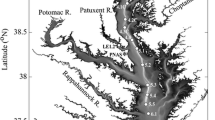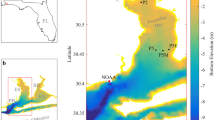Abstract
Relationships among bottom-water dissolved oxygen (DO), vertical stratification, and the factors responsible for stratification-destratification in this shallow, low tidal-energy estuary were studied using a 15-yr set of biweekly measurements, along with some recent continuous-monitoring data. Hypoxia develops only when there is both vertical water-column stratification and warm water temperature (>15°C). In July, 75% of the DO readings were <5 mg 1−1, and one-third were <1 mg 1−1. Severe hypoxia occurs more frequently in the upper half of the estuary than near the mouth. Both the time series data and correlation analysis results indicate that stratification events and DO levels are tightly coupled with variations in freshwater discharge and wind stress. Stratification can form or disappear in a matter of hours, and episodes lasting from one to several days seem to be common. Estimated summertime respiration rates in the water and sediments are sufficient to produce hypoxia if the water is mixed only every 6–12 d. There has been no trend toward lower bottom water DO in the Pamlico River Estuary over the past 15 yr. *** DIRECT SUPPORT *** A01BY059 00002
Similar content being viewed by others
Literature Cited
American Public Health Association (APHA). 1985. Standard Methods for the Examination of Water and Wastewater. 16th Ed. American Public Health Association, New York. 1,268 p.
Bales, J. D. 1990. Estuarine QW measurement. WRD Instrument News, Issue No. 49. Department of the Interior, United States Geological Survey, Water Resources Division, Stennis Space Division, Mississippi, 12 p.
Blumberg, A. F. and D. M. Goodrich. 1990. Modeling of wind-induced destratification in Chesapeake Bay. Estuaries 13:236–249.
Boesch, D. F. 1983. Implications of oxygen depletion on the continental shelf of the Northern Gulf of Mexico. Coastal Oceanography and Climatology News 2:25–29.
Christensen, J. P. and T. T. Packard. 1976. Oxygen utilization and plankton metabolism in a Washington fjord. Estuarine and Coastal Marine Science 4:339–347.
Conover, W. J. 1980. Practical Nonparametric Statistics. 2nd ed. John Wiley, New York.
Copeland, B. J., R. G. Hodson, and S. R. Riggs. 1984. The ecology of the Pamlico River estuary: An estuarine profile. United States Fish and Wildlife Service, Office of Biological Services, Washington, D.C. 83 p.
Daniel, W. W. 1978. Applied Nonparametric Statistics. Houghton Mifflin Company, Boston. 503 p.
Davis, G. J., M. M. Brinson, and W. A. Burke. 1978. Organic carbon and deoxygenation in the Pamlico River estuary. University of North Carolina Water Resources Research Institute, Report NO. 131. Raleigh, North Carolina. 123 p.
D’Elia, C. F., K. L. Webb, and R. L. Wetzel. 1981. Time varying hydrodynamics and water quality in an estuary, p. 597–606. In B. J. Neilson and L. E. Cronin (eds.), Estuaries and Nutrients. The Humana Press, New Jersey.
Falkowski, P. G., T. S. Hopkins, and J. J. Walsh. 1980. An analysis of factors affecting oxygen depletion in the New York Bight. Journal of Marine Research 38:479–506.
Garratt, J. R. 1977. Review of drag coefficients over oceans and continents. Monthly Weather Review 105:915–929.
Giese, G. L., H. B. Wilder, and G. G. Parker, Jr. 1979. Hydrology of major estuaries and sounds in North Carolina. United States Geological Survey Water Resources Investigation 79-46. Raleigh, North Carolina. 175 p.
Goodrich, D. M., W. C. Boicourt, P. Hamilton, and D. W. Pritchard. 1987. Wind-induced destratification in Chesapeake Bay. Journal of Physical Oceanography 17:2232–2240.
Haas, L. W. 1977. The effect of the spring-neap tidal cycle on the vertical salinity structure of the James, York, and Rappahannock rivers, Virginia, U.S.A.. Estuarine and Coastal Shelf Science 5:485–496.
Harper, D. E., Jr., L. D. McKinney, R. R. Salzer, and R. J. Case. 1981. The occurrence of hypoxic bottom water off the upper Texas coast and its effects on the benthic biota. Contributions in Marine Science 234:53–79.
Hirsch, R. M., J. R. Slack, and R. A. Smith. 1982. Techniques for trend analysis for monthly water quality data. Water Resources Research 18:107–121.
Hobbie, J. E., B. J. Copeland, and W. G. Harrison. 1975. Sources and fates of nutrients in the Pamlico River estuary, North Carolina, p. 287–302. In L. E. Cronin (ed.), Estuarine Research, Vol. I: Chemistry, Biology, and the Estuarine System. Academic Press, New York.
Kuenzler, E. J., D. A. Albert, G. S. Allgood, S. E. Cabaniss, and C. G. Wanat. 1984. Benthic nutrient cycling in the Pamlico River. University of North Carolina Water Resources Research Institute, Report No. 215. Raleigh, North Carolina. 148 p.
Kuo, A. Y. and B. J. Neilson. 1987. Hypoxia and salinity in Virginia estuaries. Estuaries 10:277–283.
Kuo, A. Y., K. Park, and M. Z. Moustafa. 1991. Spatial and temporal variabilities of hypoxia in the Rappahannock River, Virginia. Estuaries 14:113–121.
Nixon, S. W. 1988. Physical energy inputs and the comparative ecology of lake and marine ecosystems. Limnology and Oceanography 33:1005–1025.
Nixon, S. W. 1989. Water quality in the Pamlico River estuary—With special attention to the possible impact of nutrient dischanges from Texasgulf, Inc. Report prepared for Texasgulf, Inc. Aurora, North Carolina.
Officer, C. B., R. B. Biggs, J. L. Taft, L. E. Cronin, M. A. Tyler, and W. R. Boynton. 1984. Chesapeake Bay anoxia: Origin, development and significance. Science 223:22–27.
Ruzecki, E. P. and D. A. Evans. 1986. Temporal and spatial sequencing of destratification in a coastal plain estuary, p. 368–389. In J. Bowman, M. Yentsch, and W. T. Peterson (eds.), Tidal Mixing and Plankton Dynamics, Lecture Notes on Coastal and Estuarine Studies, Vol. 17. Springer-Verlag, New York.
Schroeder, W. W. and W. J. Wiseman, Jr. 1986. Low-frequency shelf estuarine exchange processes in Mobile Bay and other estuarine systems on the northern Gulf of Mexico, p. 355–367. In D. A. Wolfe (ed.), Estuarine Variability. Academic Press, New York.
Schroeder, W. W., S. P. Dinnel, and W. J. Wiseman, Jr. 1990. Salinity stratification in a river-dominated estuary. Estuaries 13:145–154.
Strickland, J. D. H. and T. R. Parsons 1972. A Practical Handbook of Seawater Analysis. Bulletin of the Fisheries Research Board of Canada, No. 187, 2nd Ed. Fisheries Research Board, Ottawa, Canada.
Swanson, R. L. and C. J. Sindermann (ed.). 1979. Oxygen depletion and associated benthic mortalities in the New York Bight, 1976. National Oceanic and Atmospheric Administration, Professional Paper 11, Rockville, Maryland. 345 p.
Taft, J. L., E. O. Hartwig, and R. Loftus. 1980. Seasonal oxygen depletion in Chesapeake Bay. Estuaries 3:242–247.
Tenore, K. R. 1972. Macrobenthos of the Pamlico River estuary, North Carolina. Ecological Monographs 42:51–69.
Turner, R. E., W. W. Schroeder, and W. J. Wiseman, Jr. 1987. The role of stratification in the deoxygenation of Mobile Bay and adjacent shelf bottom waters. Estuaries 10:13–19.
United States Environmental Protection Agency (USEPA). 1979. Methods for Chemical Analyses of Water and Wastes. United States Environmental Protection Agency, Washington, D.C. 430 p.
Wilkinson, L. 1988. SYSTAT: The System for Statistics. SYSTAT, Inc., Evanston, Illinois. 822 p.
Author information
Authors and Affiliations
Rights and permissions
About this article
Cite this article
Stanley, D.W., Nixon, S.W. Stratification and bottom-water hypoxia in the Pamlico River estuary. Estuaries 15, 270–281 (1992). https://doi.org/10.2307/1352775
Received:
Accepted:
Issue Date:
DOI: https://doi.org/10.2307/1352775




